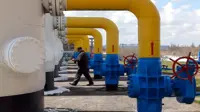A lack of structure facilitates protein synthesis
29 Jun 2011
Texts without spaces are not very legible, as they make it very difficult for the reader to identify where a word begins and where it ends.
When genetic information in our cells is read and translated into proteins, the enzymes responsible for this task face a similar challenge. They must find the correct starting point for protein synthesis.
 |
| Mechanism for the recognition of an AUG start codon by the ribosome (blue) in the absence of a Shine-Dalgarno sequence. The correct AUG start codon (green) differs from all other AUG triplets (red) through its position in a single-strand (unstructured) region of the messenger RNA (black line). © Max Planck Institute of Molecular Plant Physiology |
Therefore, in organisms with no real nucleus, a point exists shortly before the start codon, to which the enzymes can bind particularly well. This helps them find the starting point itself. However, genes that do not have this sequence are also reliably translated into proteins.
Scientists from the Max Planck Institute of Molecular Plant Physiology in Potsdam have discovered that the structure of the messenger RNA probably plays a crucial role in this process.
The DNA of all organisms consists of the four bases adenine, cytosine, thymine and guanine, which are abbreviated using the letters A, C, T and G. In RNA, thymine is replaced by uracil (U). The bases are connected with each other by their sugar-phosphate backbone. They are comparable to the letters in our alphabet, which can be put together to form words.
In the language of DNA, groups of three bases, known as triplets, code for the 20 amino acids, from which all proteins are made.
Because there are no empty spaces between the triplets in the DNA, it is difficult to recognise the three bases that belong to one triplet and, particularly, to identify the starting point for protein synthesis on the nucleic acid strand.
Before proteins can be manufactured, the DNA is transcribed into its transport form, the messenger RNA (mRNA), and introduced into the cell plasma. Small protein factories, the ribosomes, bind to the mRNA here and commence with their work.



.webp)

.webp)


.webp)
























